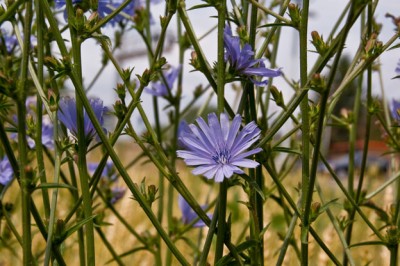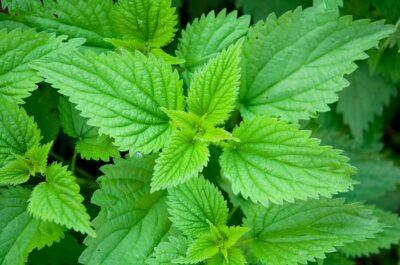
Chicory. Image source: indianapublicmedia.org
The other day here in the Missouri Ozarks, the high temperature reached 70. My wife and I took advantage of the fabulous weather and went out to our favorite mulch pile to grab a truck load for the vegetable garden that will be planted soon.
I unloaded the mulch into the garden while my wife planted peas along the fence and under some trellises. When the truck was empty, I took a quick inspection tour of the garden and found to my delight that early dandelion greens were beginning to poke through the soil. This was a great sign of a coming spring, and an early reminder that spring foraging time will be at hand soon!
For me, spring foraging is all about the salads. As the ground thaws and warms a vast array of interesting and nutritious greens explodes from the earth, and my interest in a big dinner salad is revived.
One of the first greens to show is the dandelion. Dandelion greens, when they are young and tender, add a pleasantly bitter bite to salads. They are also a great addition to soups and stews, added to the mix after most of the cooking is done. They are also a great source of potassium, and make for a wonderful spring cleansing tonic. By the time they start to flower, the leaves have become too tough and bitter for salads, but the flowers themselves are just the ticket for making a fabulous herbal wine. At this stage, the roots have also matured enough to be dug, roasted and ground into a coffee substitute or additive that is very good for the liver. Several close relatives of the dandelion, including hawkbit, catsear and nipplewort are hard to tell from dandelion as young greens, which presents no problem since they are all edible and equally tasty!
New “Survival Herb Bank” Gives You Access to God’s Amazing Medicine Chest
One of my all-time favorite foraging targets is chicory. Later in the summer and into the fall I will dig roots to roast and grind as an additive to my coffee, but in the spring they are another source of fresh and tasty greens. Young chicory leaves are great in salads, while the more mature leaves are great as a cooked vegetable. Chicory greens are rich in vitamins and minerals, and have a wide range of health benefits which include use as an anti-inflammatory for gout and arthritis, treatment of digestive ailments, and lowering of LDL cholesterol. A chicory-rich diet is recommended for weight loss regimens when there is a risk of diabetes. The leaves can also be used as a poultice in the treatment of cuts and wounds.
Nettles are another early spring treat. The tender young leaves are a great addition to soups, added late in the cooking process. Cooked nettles lose their sting. Nettles are very high in iron, and are therefore another great cleansing food and help to ward off the sluggish feeling that comes on after a winter of reduced activity. Nettles should be harvested with gloves, but if kept trimmed will yield a steady supply of tender young greens.

Stinging nettles
Rounding out the greens menu are yarrow, chick weed, and daisies. All of these plants, if the leaves are harvested early, are great additions to your salads, and can also be cooked as any other leafy vegetable. Chickweed in particular is great sautéed with another spring arrival, the wild onion. The young leaves and flower buds of daisies, before they become tough and hairy, are an excellent addition to spring salads and are an often-forgotten spring cleanser, stimulating metabolism while cleaning the blood. If you want to add a spicy zing to salads and cooked dishes alike, seek out the wild mustard. Mustard greens will take your salad up a notch, if you enjoy spicy foods.
Wild onions also should be showing up in the early spring. They are almost chive-like in their appearance and uses. The greens as well as the small bulb can be chopped into your salads or used in any cooking application. Once the onions show, wild garlic won’t be far behind and is also a welcome addition to almost any recipe. We use a lot of both of these in soups and stews to warm up on cooler spring evenings.
Many mushrooms will be making their appearance as the season changes and the weather warms. Mushrooms, however, are a whole different ball game and require a bit of expertise to safely harvest in the wild. If you are just learning mushrooms, it is an excellent idea to seek mentoring from an experienced mushroom hunter or to thoroughly study a good field guide. Once you learn the knack, however, wild mushrooms can provide a vast array of both culinary and medicinal benefits.
Your critters will also welcome the spring foraging season. It has been a rough winter in most of the country, and livestock has had to suffer through with bland, less healthful foods for some time. I know my pigs, chickens, goats and turkeys can’t wait to dig into some of the same things I have just mentioned.
Spring is a time of renewal. The return of plant life provides many tasty ways to replenish and nourish your body and to ward off ailments that may have crept in through the cold months. There is no more satisfying way to reap these rewards than through foraging for wild foods. The year’s gardening lies ahead, but for now it is time to let nature do what it does best and do the growing for you.
Sign up for Off The Grid News’ weekly email and stay informed about the issues important to you
 Off The Grid News Better Ideas For Off The Grid Living
Off The Grid News Better Ideas For Off The Grid Living




